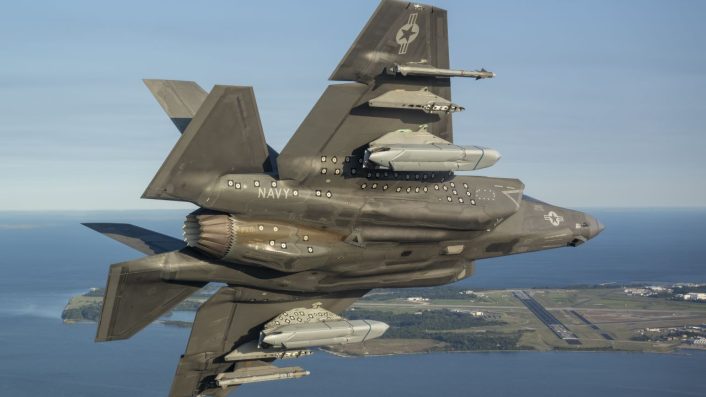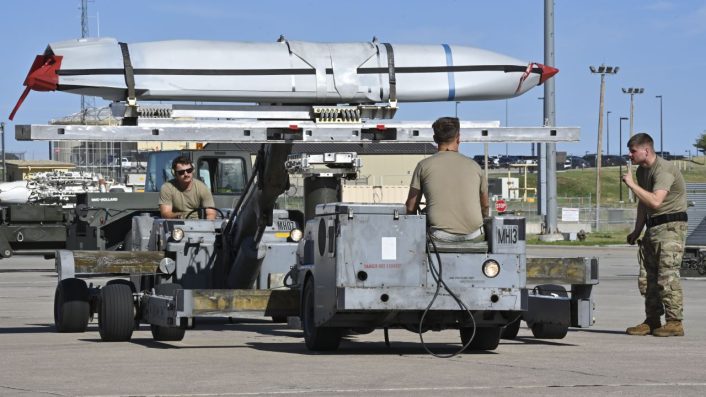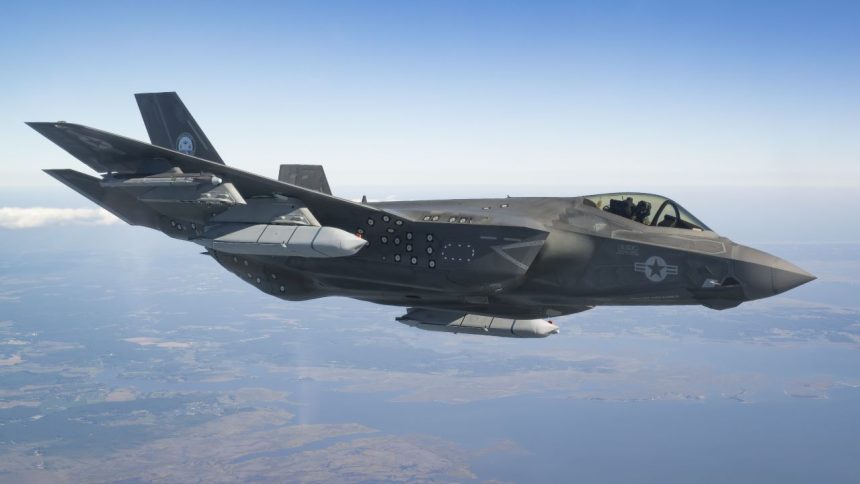The U.S. Navy has started the testing of the LRASM anti-ship weapon on the F-35C, with the first captive carry test flights in early September to evaluate the integration of the weapon and the airframe.
The U.S. military has released the first images of the AGM-158C Long-Range Anti-Ship Missile (LRASM) being carried in flight by an F-35C test aircraft from Naval Air Station (NAS) Patuxent River, Maryland. The two flights captured in the photos, which took place on Sep. 9 and 10, 2024, mark the beginning of the testing of the weapon on the F-35C.
The first test flights as part of the integration effort conducted by the Pax River F-35 Integrated Test Force (Pax ITF) showed the F-35C carrying externally two LRASMs on the innermost hardpoints, in addition to two inert AIM-9X on the wingtips. Interestingly, this is the first time the LRASM is seen with the same white paint of the JASSM from which it is derived, compared to previous photos where it was usually painted black.
These trials are usually called ‘captive carriage’ trials and are meant to test the weapon’s impact on the airframe in different flight envelopes and parameters, and verify both the systems’ core structural integrity. This represents the first phase of live flight testing before moving to in-flight drop testing to assess the weapon’s behavior during the separation and then the full weapon testing to check the entire engagement profile.
The anti-ship capability is vital in a conflict with China in the Pacific, where PLA Navy warships would be the primary combatants and targets facing U.S. and allied forces. The LRASM also saw a “historic” test in partnership with its developer Lockheed Martin and the U.S. Navy on Apr. 3, when four of the missiles were “simultaneously in flight.” The War Zone reported that it was a pair of F/A-18E/F Super Hornets that launched the four LRASMs.

The test
The caption accompanying the photograph said that the Pax ITF flew two days of test flights earlier this month as part of the ongoing efforts to certify the F-35C to carry the LRASM. The first two flights allowed to evaluate flutter, loads, and flying qualities with two AGM-158 loaded on external stations, said the caption. The LRASMs in both the pictures also have a blue band on the front, indicating they are inert variants.
The Pax ITS described the LRASM as “a defined near-term solution for the Offensive Anti-Surface Warfare (OASuW) air-launch capability gap that will provide flexible, long-range, advanced, anti-surface capability against high-threat maritime targets.” The Pax River ITF’s is in charge of the planning, coordination, and conduction of safe, secure, and efficient flight testing for both the F-35B and C variants, and provide necessary and timely data to support program verification/certification and fleet operational requirements.
Beside checking the impact on flight characteristics during carriage and electronic launches, confirming the links between the fire control and missile ejection devices on the hardpoints, the testing might also develop or inform specific launch parameters to obtain the missile’s optimal performance.
Glossy black VX-9 Vandy 1 carrying glossy black live LRASM, how cool is that pic.twitter.com/wLzUT8ua0U
— Fighterman_FFRC (@Fighterman_FFRC) August 16, 2024
JASSM & F-35
The AGM-158C LRASM is the anti-ship variant of the AGM-158 Joint Air-to-Surface Standoff Missile (JASSM). It is designed to be carried by both the F-35B Short Take-Off Vertical Landing (STOVL) used by the U.S. Marine Corps, and U.S. Navy’s the F-35C and F/A-18 Super Hornet carrier catapult-launched jets.
As seen in the photos, the LRASM is being carried by the F-35C externally on the wing hardpoints since it is too large to fit inside its weapons bays. The weapon would face a similar issue with the F-35B too, which has smaller bays.
The original JASSM has several variants, including the baseline AGM-158A JASSM that is no longer in production. The AGM-158B JASSM-ER is the baseline of the extended range version, whose AGM-158B-2 and the AGM-158B-3 variants have different and upgraded electronic circuitry, guidance, navigation and seeker systems.
According to The War Zone, the AGM-158D JASSM-ER has a WDL (Weapon Data Link) capability that allows retargeting/retasking the missile mid-flight. The capability was mentioned in the Air Force’s Fiscal Year 2025 budget documentation and is still under development.

Similarly to the LRASM with the F-35C, the F-35A also can’t carry the AGM-158A JASSM internally. Because of this, the U.S is acquiring the Norwegian Kongsberg Defence and Aerospace’s (KDA) Joint Strike Missile (JSM) in a $141 million contract that was announced on May 31, 2024. The JSM, the land-strike version of the Naval Strike Missile (NSM), is compatible with the F-35 internal weapons bays.
LRASM & U.S. Navy
With the emerging maritime theater in the western Pacific before China, the U.S. Navy would need to bear down significant mass in anti-shipping strikes against PLA (People’s Liberation Army) Navy warships, or at least a single or a few surface combatants, to achieve localized naval superiority. Missiles that can change directions and flight paths at unpredictable intervals to evade Chinese Air Defense (AD) systems would be invaluable, and particularly lethal when launched together in salvos.
Once launched, LRASM guides to an initial point using a GPS guidance system and employs onboard sensors to locate, identify, and provide terminal guidance to the target. Semi-autonomous guidance algorithms will allow it to use less-precise target cueing data to pinpoint specific targets in the contested domain.
Lockheed Martin described the April’s 12th Integrated Test Event (ITE-12) with the four LRASMs and the F/A-18 Super Hornets as demonstrating the weapon’s “inherent high-end lethality from mission planning through kill chain integration and its effects on the target.”
There are currently three variants which comprise the OASuW Increment 1 program, designated LRASM 1.0, LRASM 1.1, and LRASM C-3. The LRASM 1.0 variant, which was fielded with early operational capability in 2019, has already been integrated on the B-1B Lancer and F/A-18E/F Super Hornet. The newer LRASM 1.1 variant was fielded last year and is undergoing Initial Operational Test & Evaluation this year, according to the Director, Operational Test and Evaluation’s report.
The successful ITE-12 test we previously mentioned was considered as a graduation exercise for the missiles’ latest configuration and lays the foundation for increased capabilities to come, said NAVAIR. The AGM-158C LRASM is also being integrated on the P-8A Poseidon Maritime Patrol Aircraft (MPA).
Although external carriage will sacrifice stealth, a fleet of F-35s and F/A-18 Super Hornets with possibly longer-range variants of the LRASM, able to receive target location updates from both the launching fighters and own and Allied naval, air combat and surveillance assets, would be a tremendous capability. The current AGM-158C LRASM reaches just over 321 km with a 453 kg blast fragmentation warhead.
Programs to extend the JASSM and the LRASM range in general are very much being pursued, as the greater reach is always welcome since it keeps the launching platforms further away from enemy assets. Military Aerospace reported on May 14 that the Naval Air Systems Command (NAVAIR) announced a potential $288 million order to Lockheed Martin for developing an AGM-158C-3 extended-range LRASM. This is envisaged to have a range of 1,600 km.
JASSM XR https://t.co/iEiDOo0r51 pic.twitter.com/MHSaX3Isuy
— Alex 🌻 (@alexgarcialonso) September 15, 2024
Lockheed Martin also recently unveiled a mock-up of the AGM-158 Extreme Range (XR) during the U.S. Air Force’s Air, Space and Cyber 2024 gathering. Although an internally-funded initiative, it is unlikely the DoD would not be interested in longer-range variants of their primary air-launched standoff surface-strike weapon.









